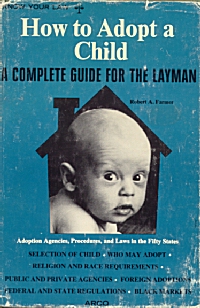
How to Adopt a Child:
A Complete Guide for
the Layman
by Robert A. Farmer
Arco Publishing Co., 1967
Reviewed by Barbara Free
In this book, birth parents are rarely even mentioned, and then only in terms of making sure they have no way of “tracking down” their children or the adoptive parents, and they are not called birth parents or birth mothers, but natural parents or “unwed mothers” or “parents of illegitimate children.” It is assumed that “Negro babies” are unadoptable in the same way as babies discovered to be blind; mentioned in the same way in the same sentence, in fact. Adoption laws for each state are detailed, including that in Texas and Louisiana, interracial adoptions are specifically illegal. States that require all adoptions be handled through agencies with “career social workers running them” are lauded. The safeguards for babies and for adoptive parents (not necessarily in that order) are repeatedly detailed, but nowhere in the entire book is there mention of any safeguards for birth parents, other than that some states have laws against “natural mothers” being forced to give “their consent” for relinquishment while still in the delivery room. If all of this sounds far away and medieval, one must be reminded of the publication date, 1968, the time during which many birth mothers in O.I. relinquished and the time during which many O.I. adoptees were born.
Reading the book, painful as it may be for birth parents, adoptees, and adoptive parents alike, it offers a great deal of insight into the social, emotional, and legal situation of that time, which greatly affected nearly everyone who has become involved in O.I. and similar groups. It is important reading for persons involved in searches and reunions and persons in relationships with adoptees, birth parents or adoptive parents. It is so difficult for many to transport themselves back to that time, and so important to be able to do that in order to understand decisions that were made then. At the time, the book states, “illegitimacy in the United States has risen to a very high level, insuring a constantly high supply of children available for adoption.” My, how times have changed! Yet, old attitudes and beliefs about adoption linger.
O.I. members are encouraged to read this book and record their own reactions on the paper which will be included inside the book. A future newsletter article will discuss the reactions.
Excerpted from the July 2003 edition of the Operation Identity Newsletter
© 2003 Operation Identity